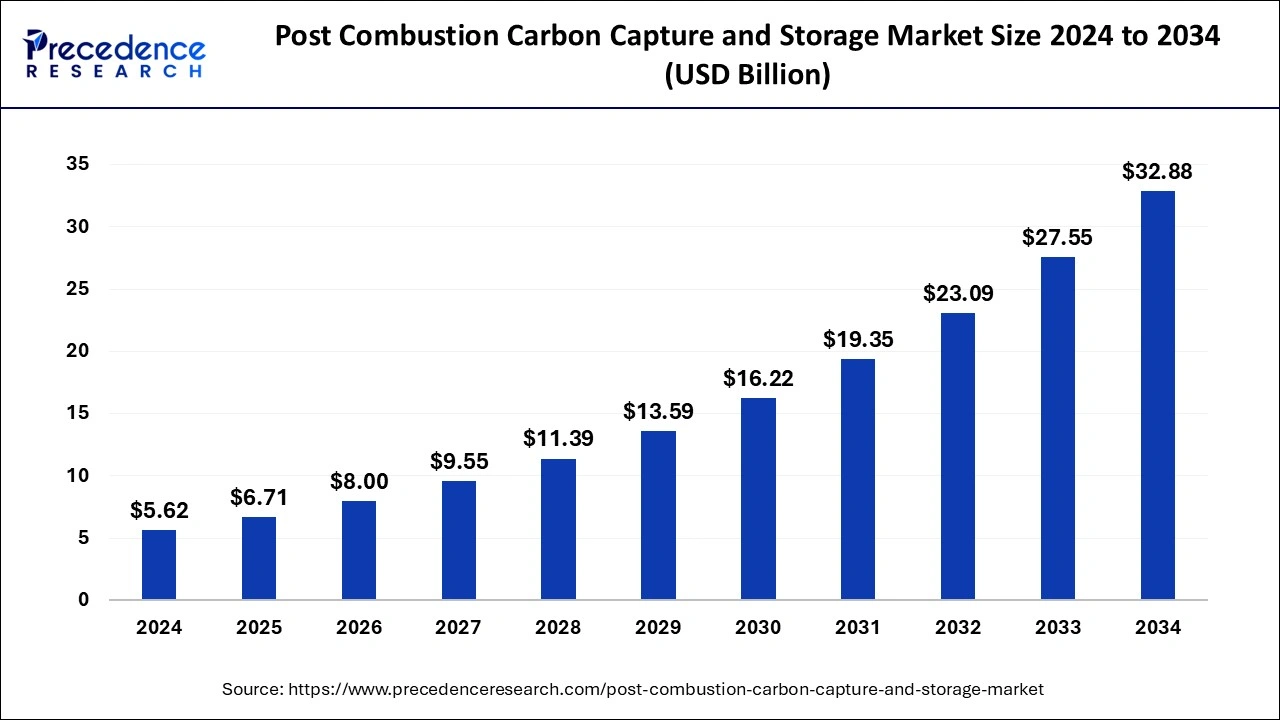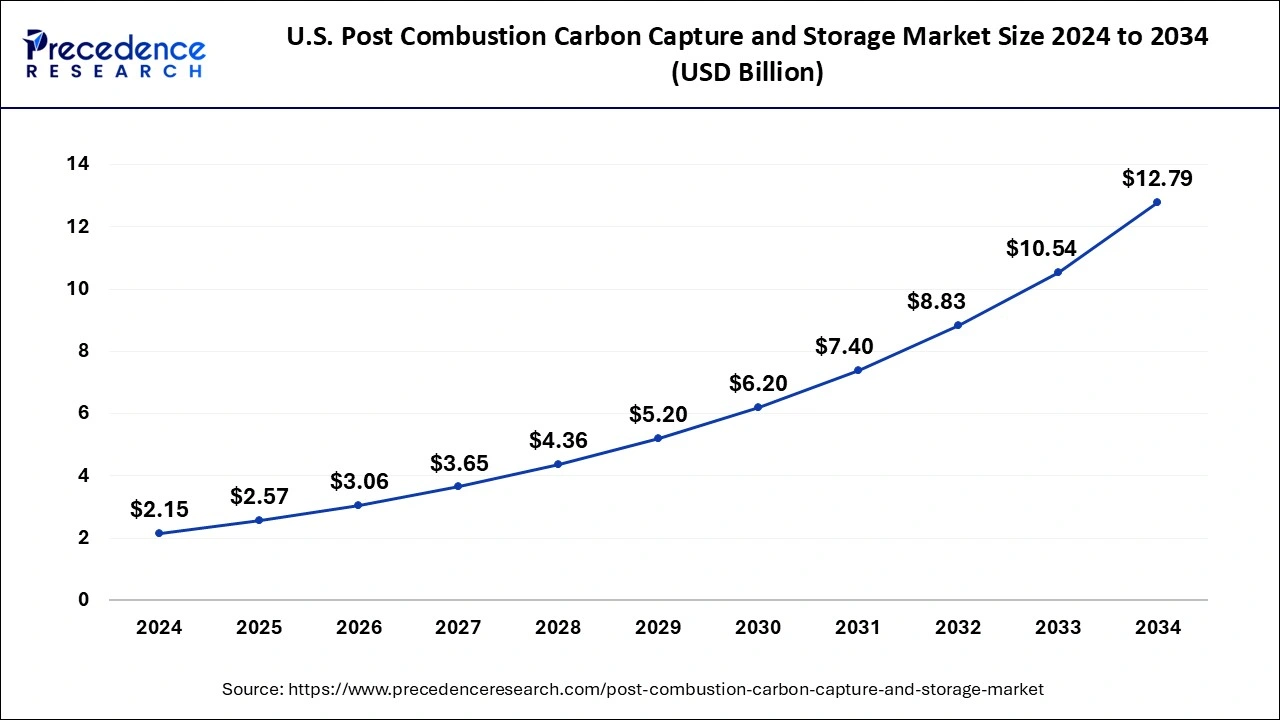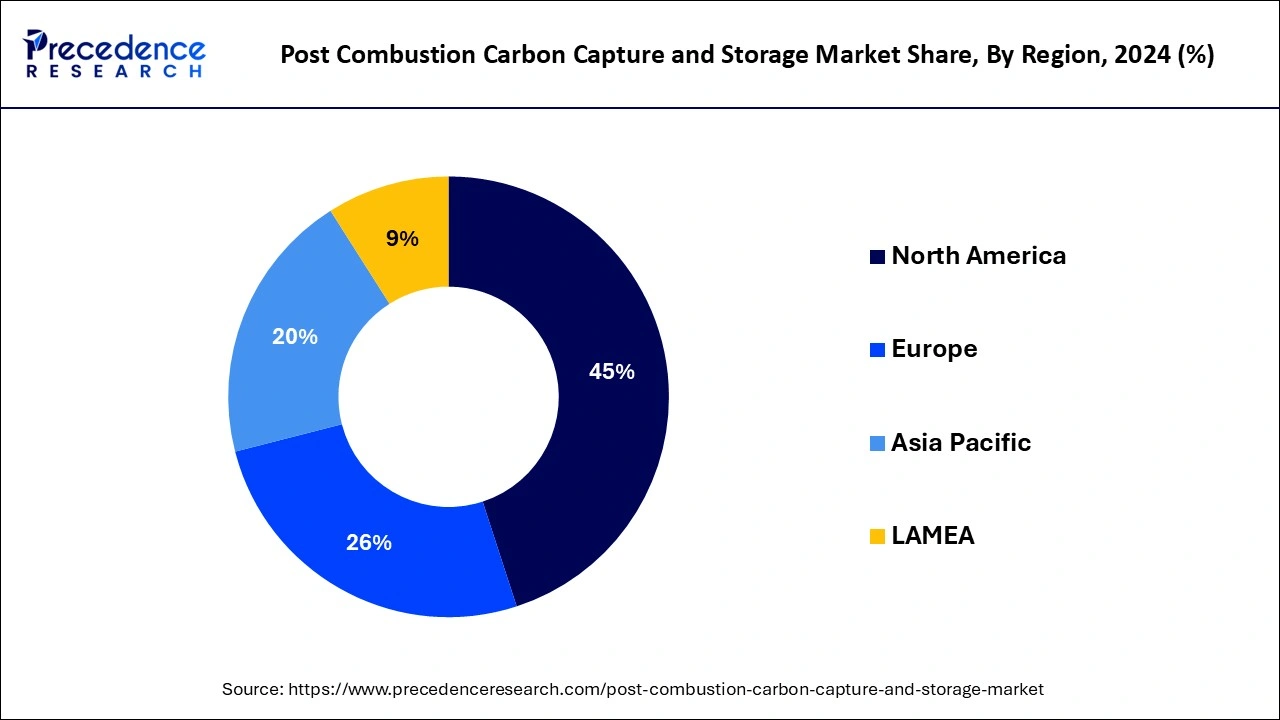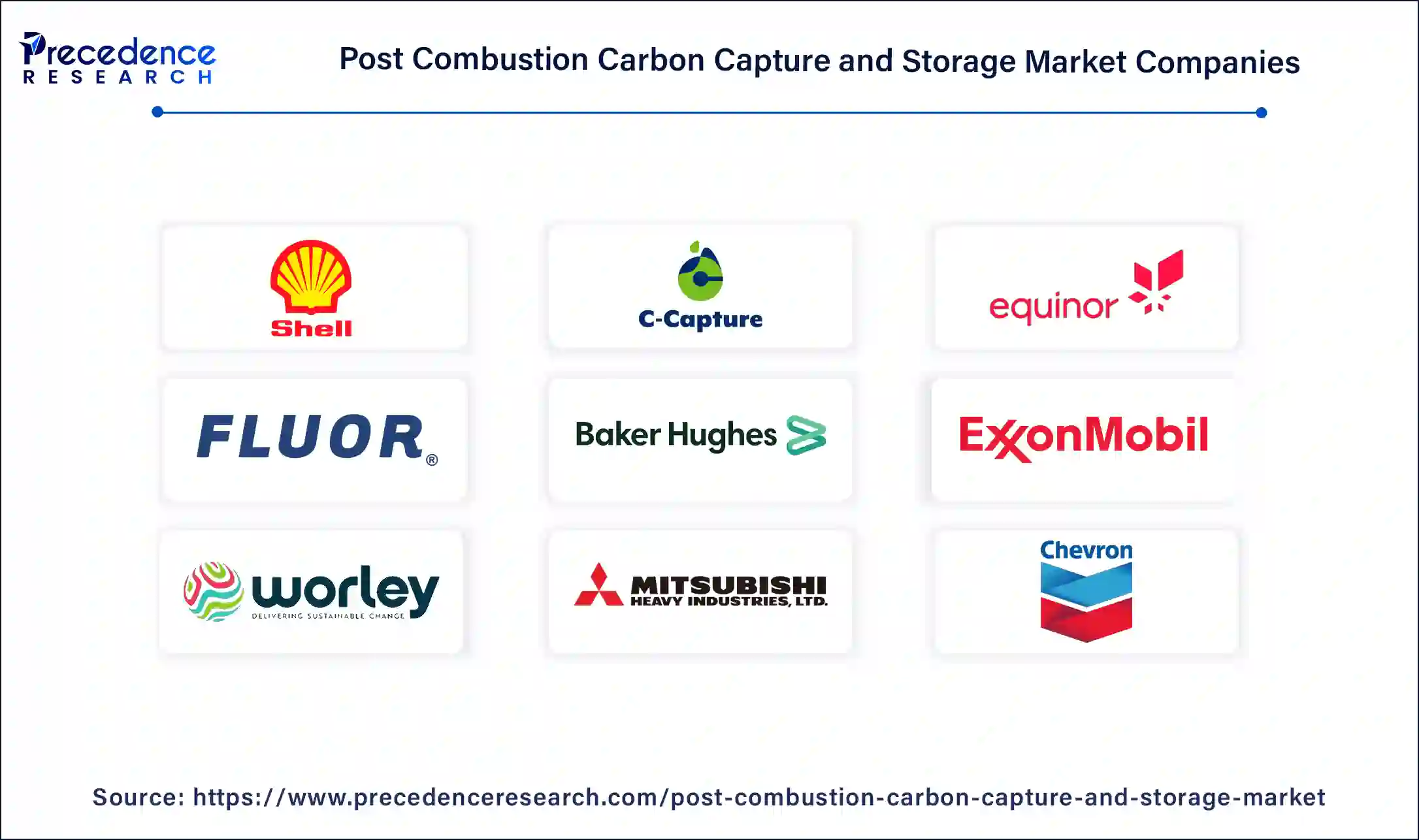October 2024
The global post combustion carbon capture and storage market size is calculated at USD 6.71 billion in 2025 and is forecasted to reach around USD 32.88 billion by 2034, accelerating at a CAGR of 19.32% from 2025 to 2034. The North America market size surpassed USD 2.53 billion in 2024 and is expanding at a CAGR of 19.44% during the forecast period. The market sizing and forecasts are revenue-based (USD Million/Billion), with 2024 as the base year.
The global post combustion carbon capture and storage market size accounted for USD 5.62 billion in 2024 and is expected to exceed around USD 32.88 billion by 2034, growing at a CAGR of 19.32% from 2025 to 2034. The post combustion carbon capture and storage market is rapidly growing due to increased regulations of carbon emissions, innovation, and expanding investments.

Artificial intelligence can enhance the operation of the post combustion carbon capture and storage market by regulating operating parameters and predicting capture rates to increase efficiency and reduce costs. Industries can enhance rates of COâ‚‚ capture while preserving resources by using industrial AI algorithms-based parameters such as the concentration of solvents, pressure, and temperature. Optimization in equipment maintenance is done through the use of artificial intelligence in the early identification of anomalies.
The U.S. post combustion carbon capture and storage market size was exhibited at USD 2.15 billion in 2024 and is expected to be worth around USD 12.79 billion by 2034, growing at a CAGR of 19.52% from 2025 to 2034.

North America accounted for the largest share of the post combustion carbon capture and storage market share in 2024. The utilization of CO2 in the Enhanced Oil Recovery method, combined with the rising trend of clean technology, will further boost the market in the United States and other countries, including Canada. The technologies are currently used widely in industries such as power generation and manufacturing through the application of post combustion capture. Market expansion is predicted to occur with government pressures toward carbon neutrality goals and the development of several large-scale CCS projects by energy giants.

Asia Pacific is anticipated to witness the fastest growth in the post combustion carbon capture and storage market during the forecasted years. Global industrialization has enhanced the emission of carbon, thus forcing governments to enact strict environmental policies and encourage the use of green technology. Several Asian countries like China, Japan, and South Korea use CCS technologies to reduce emissions from power generation based on coal and vast industries like cement and steel industries. Aimed at encouraging environmentally friendly energy generation techniques and emission restrictions are driving the use of CCS systems.
Post combustion carbon capture and storage is a process by which carbon dioxide (CO2) is removed from the flue gases of a power plant after the combustion of fossil fuels and storing the removed CO2 in geological formations. The flue gases resulting from combustion have gained traction due to their ability to retrofit existing power plants and industries, making it a sustainable solution for industries looking to lessen their carbon footprint.
Rising carbon emissions across the world and a growing concern about the impact of carbon on the environment have favored the adoption of this carbon capture and storage across the globe thus boosting the post combustion carbon capture and storage market. Governments worldwide are working on promoting this technology through pilot projects in different industries. The technology is accepted for its potential as a large-scale solution to achieve ambitious CO2 emission reduction targets and address climate control objectives.
| Report Coverage | Details |
| Market Size by 2024 | USD 5.62 Billion |
| Market Size in 2025 | USD 6.71 Billion |
| Market Size in 2034 | USD 32.88 Billion |
| Market Growth Rate from 2025 to 2034 | CAGR of 19.32% |
| Dominating Region | North America |
| Fastest Growing Region | Asia Pacific |
| Base Year | 2024 |
| Forecast Period | 2025 to 2034 |
| Segments Covered | Technology, Application, and Regions |
| Regions Covered | North America, Europe, Asia-Pacific, Latin America, and Middle East & Africa |
Implementing sustainable technologies for manufacturing
The post combustion carbon capture and storage market is driven by several factors contributing to its growth and impact on substantial decarbonization. These technologies can capture and store carbon dioxide emissions, decreasing greenhouse gas emissions and modifying climate change impacts. Also, the use of sustainable technologies in industries such as manufacturing and chemicals drives the demand for carbon capture and storage solutions. These industries recognize the need to control CO2 emissions and meet emission reduction targets. Through carbon capture and storage technologies, they can effectively capture and store CO2 emissions, allowing them to meet regulatory requirements and increase their environmental performance.
High installation cost
The restraint with the implementation of the post combustion carbon capture and storage market is its high initial cost. Cost estimates for establishing CCS are high, particularly in the costs of equipment for carbon dioxide capture, compression equipment, pipelines, and reservoirs. Extending green construction to current structures is another cost factor, especially in power or industrial plants. Furthermore, the CCS operation is energy-intensive, thus implying more establishment running costs and discouraging adoption. Small and developing industries in developing countries are most affected as they cannot afford these systems.
Government regulations and incentives
Government policies and regulations are accelerating the acceptance of the post combustion carbon capture and storage market technologies. Supportive processes like carbon pricing, emission standards, and financial incentives boost industries to invest in these solutions. Also, CCS is used in different sectors of industry, especially cement and steel industries, which emit a large amount of CO2. Further novel technologies and practices are currently emerging in the processes of capturing carbon dioxide from flue gas generated after the burning of fossil fuels. These include low-cost, more efficient solvents for capturing CO2, new and enhanced novel capture processes, and new materials for the capture system.
The post-combustion carbon capture segment noted the largest share of the post combustion carbon capture and storage market in 2024. Customers can use post combustion carbon capture as an effective method for trapping CO2 from flowing flue gases and meeting emissions limits. Carbon dioxide recovered from flue gases generated when the primary fuel burns in the presence of air is captured using post combustion technology. Such systems usually use a liquid solvent to dissolve a small amount of carbon dioxide in the flue gas streams, of which nitrogen is the main component. In addition, main driving and post combustion capture technology is expected to have a higher growth rate. These include enhanced electricity generation coupled with the improvement of new amine systems and the incorporation of heat systems, which are expected to contribute significantly towards post combustion capture technology demand over the forecast period.
The pre-combustion carbon capture segment is projected to witness the fastest growth in the post combustion carbon capture and storage market during the forecast period. Integrated Flow Solutions Pre combustion carbon capture is a process that is used to eliminate carbon dioxide (CO2) from fuel before burning it. It's more efficient than post combustion technology because the CO2 is more concentrated. Pre combustion CO2 capture using the water gas shift reaction (WGSR) and its removal with acid gas removal (AGR) process is commercially carried out.
The power generation segment has contributed a significant share of the post combustion carbon capture and storage market in 2024. Post combustion carbon capture and storage involves capturing carbon dioxide (CO2) from the flue gases in a power plant and storing it in geological formations. Owing to high greenhouse gas emission rates, the potential of using carbon capture and storage technology is extremely high in coal-fired power plants. When post combustion capture technology is combined with other renewable energy systems, such as biomass power plants or solar thermal power plants, the resulting emissions can be balanced, and low carbon electricity can be generated.

As mentioned by Atoco’s CEO, Dr. Samer Taha, in an interview with Carbon Pulse, the present and future applications of Atoco’s solid-state carbon material are indeed revolutionary. It is also essential to note that our technology has the ability to selectively capture CO2 at much lower concentrations than other technologies. This makes it versatile and applicable for both post combustion carbon capture and direct air capture (DAC). Although it is primarily aimed at natural gas power plants, this solution has many more possible uses in the future.
By Technology
By Application
By Geography
For inquiries regarding discounts, bulk purchases, or customization requests, please contact us at sales@precedenceresearch.com
No cookie-cutter, only authentic analysis – take the 1st step to become a Precedence Research client
October 2024
January 2025
February 2025
February 2025